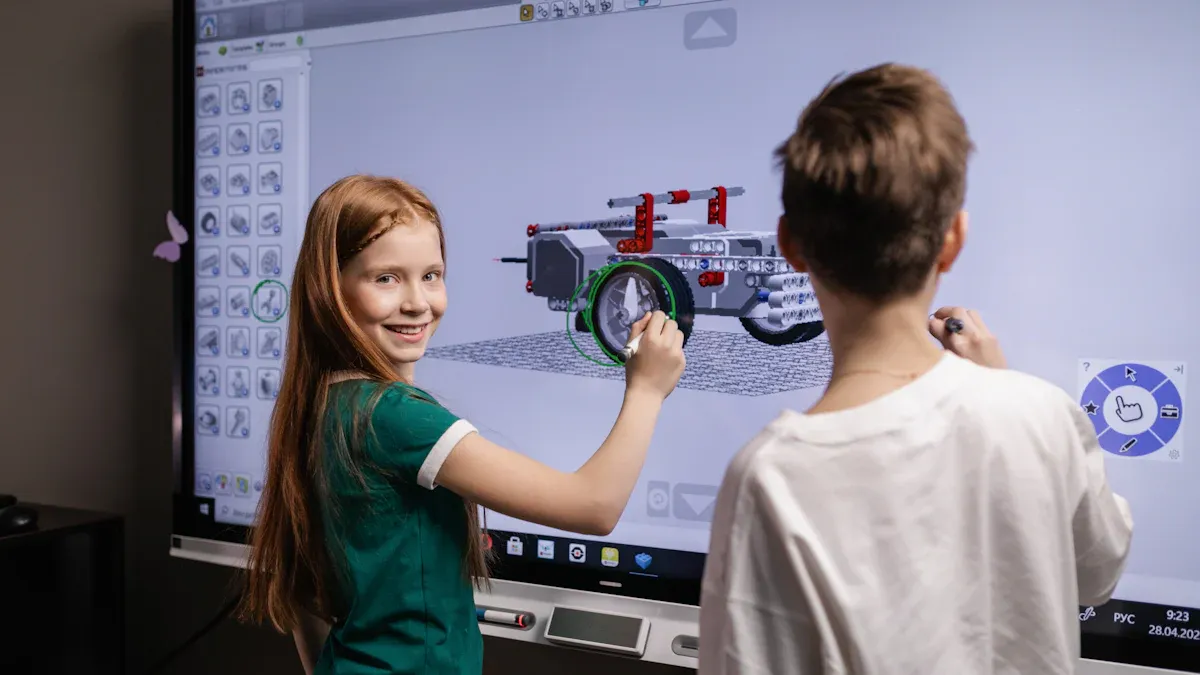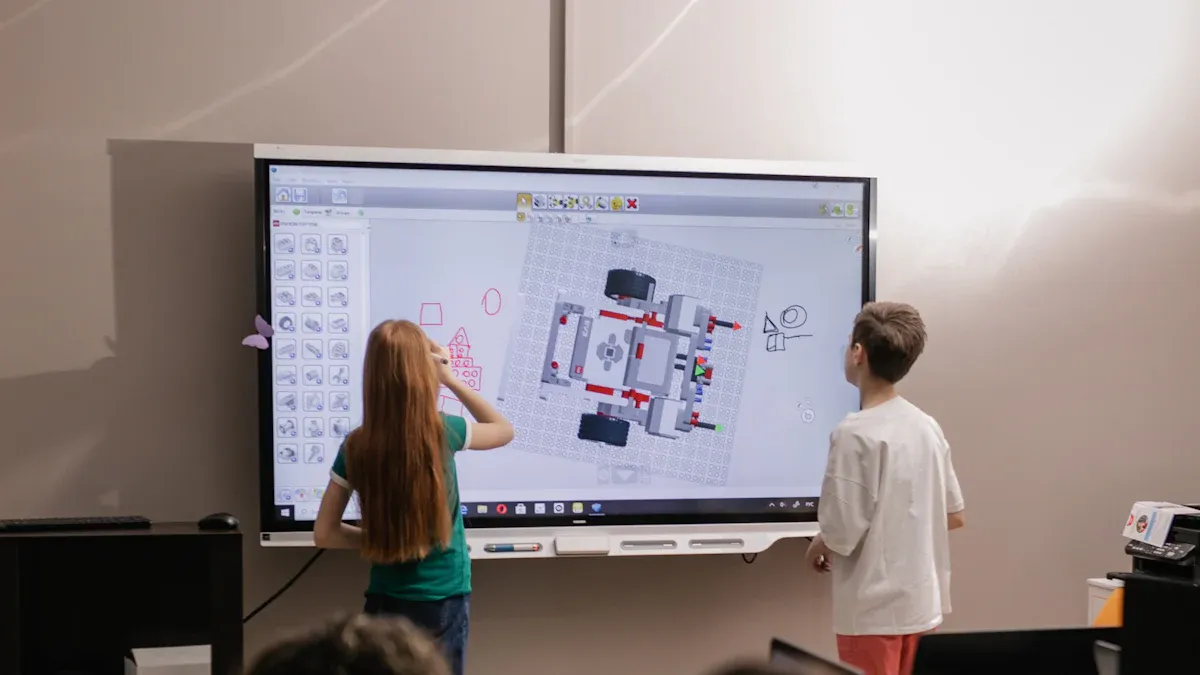
Smart boards have changed how you teach and learn. These tools allow you to meet the needs of students with different learning styles. With a smart board in classroom settings, you can create lessons that are interactive and easy to follow. Students can see, hear, and interact with the content, making learning more engaging. For students with disabilities, smart boards help remove barriers by offering features like touch controls and screen readers. These tools give you the ability to make learning accessible to everyone.
Smart boards help different learners by using pictures, sounds, and activities. Show videos for visual learners, play audio for auditory learners, and use hands-on tasks for kinesthetic learners.
Add tools like screen readers and zoom features for students with disabilities. These tools make sure everyone can understand and use the lessons.
Use smart boards to let students work together in shared spaces. This builds teamwork and helps them learn from each other.
Include videos and animations to make lessons fun and exciting. These tools help students learn in ways that match how they understand best.
Ask students for feedback about using smart boards often. Use polls or surveys to learn what they need and make classes better.

A smart board in classroom settings helps you address the unique ways students learn. Some students grasp concepts better through visuals, while others prefer hands-on activities or auditory explanations. Smart boards allow you to combine these methods in one lesson. You can display images, play videos, and use interactive tools to cater to different preferences.
For example, you can use the drawing feature to illustrate complex ideas for visual learners. Auditory learners benefit from the ability to play recorded explanations or interactive audio clips. Kinesthetic learners can engage directly with the board by dragging and dropping elements or solving puzzles. This flexibility ensures that every student has an opportunity to connect with the material in a way that suits them best.
Smart boards are powerful tools for creating an inclusive environment for students with disabilities. They integrate assistive technologies that make learning accessible.
Screen readers and speech-to-text software help students with learning disabilities access content more effectively.
Magnification tools and color contrast adjustments support students with visual impairments.
Shared digital workspaces encourage group discussions, helping students develop communication and problem-solving skills.
These features remove barriers and allow students with disabilities to participate fully in classroom activities. For instance, a student with limited vision can use magnification tools to read text clearly, while another with difficulty writing can use speech-to-text software to complete assignments.
Smart boards transform lessons into interactive experiences that capture students' attention. Instead of passively listening, students actively engage with the material. You can use quizzes, games, and polls to make learning fun and dynamic.
Studies show that smart classrooms significantly improve academic achievement and creativity compared to traditional classrooms.
Aspect | Traditional Classroom | Smart Classroom | Difference |
|---|---|---|---|
Academic Achievement | Lower | Higher | Significant |
Creativity | Lower | Higher | Significant |
When students participate actively, they retain information better and feel more connected to the learning process. This engagement fosters a sense of belonging and encourages collaboration among peers.
Smart boards create opportunities for students to work together effectively. They act as shared digital workspaces where students can brainstorm ideas and collaborate on group projects. You can use them to facilitate activities that require teamwork, such as solving problems or creating presentations. This shared interaction builds communication skills and encourages students to learn from one another.
Students can interact with the board simultaneously, adding their thoughts or editing content in real time.
Group activities become more engaging when students use interactive tools to explore topics collaboratively.
Flipped classrooms benefit from smart boards by allowing students to review material online and use class time for group discussions and hands-on exploration.
Interactive whiteboards also enhance critical thinking. When students work together to solve problems, they develop a deeper understanding of the subject matter. You can use the board to display challenges or puzzles that require teamwork to solve. This approach not only strengthens their problem-solving abilities but also fosters interpersonal skills.
Tip: Use collaborative tools like brainstorming apps or shared drawing features on the smart board to encourage teamwork. These tools make group activities more dynamic and inclusive.
Smart boards also support hybrid learning environments. Whether students are in the classroom or participating remotely, they can contribute to group tasks through shared platforms. This flexibility ensures that every student has a chance to participate, regardless of location.
By integrating smart boards into your lessons, you create a classroom culture that values collaboration. Students learn to appreciate diverse perspectives and work together toward common goals. This teamwork prepares them for future challenges, both academically and socially.
Smart boards offer a range of interactive features that make learning more engaging and hands-on. These tools allow students to interact with lessons in ways that feel natural and intuitive, much like using a smartphone or tablet. For example, students can touch, drag, and manipulate objects on the screen to solve problems or complete activities. This hands-on approach encourages active participation and helps students retain information more effectively.
The large screen size and vibrant visuals of a smart board capture attention and cater to different learning styles. You can display videos, animations, or interactive diagrams to explain complex topics. Additionally, smart boards integrate internet resources and specialized software, allowing you to bring real-world examples into the classroom. This variety keeps lessons fresh and exciting, motivating students to stay engaged.
Interactive whiteboards also help you organize lesson materials. You can save and revisit content, making it easier for students to review key concepts. This accessibility ensures that no one falls behind and that every student has the opportunity to succeed.
Tip: Use interactive quizzes or games on the smart board to make lessons more dynamic. These activities not only reinforce learning but also make the classroom environment more enjoyable.
Smart boards come equipped with features that support students with disabilities, ensuring that everyone can participate in the learning process. For instance, you can use screen readers to assist students with visual impairments or speech-to-text tools for those who struggle with writing. These technologies make it easier for students to access and engage with the material.
Magnification tools and adjustable color contrast settings are particularly helpful for students with low vision. By customizing these settings, you can create a more comfortable and inclusive learning environment. Additionally, smart boards allow you to incorporate multimedia content, such as audio recordings or videos with captions, which benefits students with hearing impairments or language processing challenges.
Assistive technologies also promote independence. Students can use these tools to complete tasks on their own, boosting their confidence and sense of accomplishment. By integrating these features into your lessons, you ensure that all students feel valued and included.
Note: Regularly explore the accessibility settings on your smart board to discover new ways to support diverse learning needs.
Collaboration is a key element of an inclusive classroom, and smart boards provide excellent tools to encourage teamwork. Digital whiteboards, for example, allow students to contribute ideas in real time. Whether brainstorming solutions to a problem or working on a group project, students can interact with the board simultaneously, ensuring that every voice is heard.
These tools also make it easy to conduct icebreakers or quick check-ins, helping students feel more connected to their peers. By fostering a sense of community, you create a classroom environment where everyone feels welcome and valued.
Smart boards are particularly effective in hybrid learning settings. Students attending remotely can participate in group activities through shared platforms, ensuring that they remain engaged and included. This flexibility is essential for creating a truly inclusive educational experience.
Tip: Use collaborative apps or shared drawing features on the smart board to encourage group participation. These tools make teamwork more interactive and enjoyable.
By leveraging the collaborative features of a smart board, you not only enhance learning but also teach students important social skills. Working together on tasks helps them appreciate diverse perspectives and prepares them for future challenges.
Smart boards allow you to incorporate multimedia into your lessons, making learning more dynamic and inclusive. Multimedia tools like videos, animations, and audio clips cater to different learning preferences. By using these tools, you can create lessons that engage students visually, audibly, and interactively. This approach ensures that every student connects with the material in a way that suits their learning style.
For example, you can use videos to explain abstract concepts or animations to demonstrate processes step-by-step. Audio clips can help auditory learners grasp key ideas, while interactive simulations provide hands-on experiences for kinesthetic learners. These varied methods keep students interested and motivated to learn.
Tip: Use multimedia to break down complex topics into smaller, more digestible parts. This helps students process information more effectively.
Smart boards make it easy to combine multimedia with differentiated instruction. Differentiated instruction tailors teaching methods to meet the unique needs of each student. By leveraging multimedia, you can address these needs more effectively.
Here’s how different multimedia strategies impact differentiated instruction:
Multimedia Strategy | Impact on Differentiated Instruction |
|---|---|
Incorporating multimedia resources | Engages students with different learning preferences through varied media. |
Leveraging technology for personalized learning | Provides insights on student progress, allowing tailored instruction. |
Utilizing varied instructional methods | Caters to diverse learning preferences, enhancing overall learning experience. |
These strategies ensure that no student feels left out. For instance, a student who struggles with reading can benefit from videos or audio explanations, while another who excels in visual learning can explore diagrams and charts.
Mix Media Types: Combine videos, images, and text to create a balanced lesson. This keeps students engaged and prevents monotony.
Use Interactive Features: Incorporate quizzes or games that use multimedia elements. These activities make learning fun and reinforce key concepts.
Provide Options: Let students choose how they want to engage with the material. For example, offer a video explanation alongside a written summary.
By integrating multimedia into your lessons, you create a classroom environment that values diversity in learning. Students feel more confident and capable when they can access content in ways that resonate with them.
Note: Regularly update your multimedia resources to keep lessons fresh and relevant. This ensures that students remain engaged and excited to learn.
Smart boards give you the tools to transform your teaching. By using multimedia effectively, you can create lessons that inspire and empower every student in your classroom.
Smart boards offer a variety of accessibility settings that help you create an inclusive learning environment. You can adjust features like font size, color contrast, and screen magnification to meet the needs of students with visual impairments. These settings ensure that every student can access the content comfortably.
Explore the built-in tools to support students with disabilities. For example, screen readers can assist students who struggle with reading, while touch controls make it easier for students with motor challenges to interact with the board. Regularly review these settings to ensure they align with your students' needs.
Tip: Encourage students to share feedback on accessibility settings. Their input helps you refine the learning experience and make it more inclusive.
To maximize the benefits of a smart board in classroom settings, educators need proper training. Familiarize yourself with the interactive features, assistive technologies, and multimedia tools available. This knowledge allows you to design lessons that engage and support all students.
Organize workshops or training sessions to help educators master smart board functionalities. Hands-on practice builds confidence and ensures effective use of the technology. You can also create a resource guide with step-by-step instructions for common tasks, such as setting up collaborative activities or customizing accessibility features.
Note: Continuous learning is key. Stay updated on new features and software updates to keep your teaching methods fresh and effective.
Smart boards should enhance your teaching goals, not distract from them. Begin by identifying your lesson objectives and then determine how the smart board can support those goals. For example, use interactive quizzes to assess understanding or multimedia tools to explain complex concepts.
Plan your lessons to integrate the smart board seamlessly. Avoid overloading students with too many features at once. Instead, focus on tools that directly contribute to the learning outcomes. This approach ensures that the technology serves its purpose without overwhelming the classroom experience.
Tip: Use the smart board to track student progress. Features like shared workspaces and saved lessons help you monitor individual and group achievements effectively.
Gathering feedback from students helps you improve how you use smart boards in the classroom. Their input gives you valuable insights into what works and what doesn’t. When students share their thoughts, you can adjust your teaching methods to better meet their needs.
Start by creating opportunities for students to express their opinions. Use the smart board itself to collect feedback. For example, you can set up interactive polls or surveys where students rate their experience with specific features. You can also use brainstorming apps to let students suggest ideas for improving lessons.
Tip: Keep feedback activities simple and fun. Use emojis or icons in surveys to make them more engaging for younger students.
Encourage students to share feedback regularly. Make it part of your routine by asking them to reflect on lessons at the end of each week. You can display a question on the smart board, such as “What did you enjoy most about today’s lesson?” or “What could we do differently next time?” This approach helps students feel heard and valued.
Feedback doesn’t have to be formal. Casual discussions during group activities or one-on-one conversations can reveal helpful insights. Pay attention to how students interact with the smart board and ask follow-up questions to understand their preferences.
Feedback Method | Benefits |
|---|---|
Interactive Polls | Quick and easy way to gather opinions. |
Group Discussions | Encourages open communication. |
Weekly Reflections | Helps track progress over time. |
When you act on student feedback, you show them that their opinions matter. This builds trust and creates a more inclusive classroom environment. Students feel more connected to the learning process when they see their ideas shaping how lessons are delivered.
Note: Review feedback regularly and share updates with students. Let them know how their suggestions are being implemented.

Smart boards help you create a welcoming environment for English Language Learners (ELLs). These students often face challenges with language comprehension and vocabulary. Using smart boards, you can integrate visual aids, interactive activities, and multimedia to make lessons more accessible.
For example, you can display images alongside key vocabulary words to help students associate meanings visually. Interactive translation tools on the smart board allow students to see words in their native language while learning English. Videos with subtitles provide additional context, making it easier for ELLs to grasp complex ideas.
Group activities on the smart board also encourage collaboration. Students can work together to complete tasks, fostering communication skills and building confidence. By using these tools, you create a classroom where ELLs feel supported and included.
Tip: Use interactive quizzes with visual and auditory cues to reinforce language learning for ELLs.
Smart boards offer features that make learning accessible for students with visual impairments. You can adjust font sizes, increase screen magnification, and modify color contrast to ensure readability. These settings allow students to engage with the material comfortably.
For instance, a student with low vision can use magnification tools to explore detailed diagrams or charts. Screen readers can read aloud text displayed on the board, helping students follow along with lessons. You can also incorporate tactile learning by pairing smart board activities with physical objects for hands-on exploration.
These tools empower students with visual impairments to participate actively in classroom activities. They gain independence and confidence as they interact with the content in ways that suit their needs.
Note: Regularly check accessibility settings to ensure they align with your students' requirements.
Students with Autism Spectrum Disorder (ASD) often benefit from structured and visually engaging lessons. Smart boards provide the flexibility to create such environments. You can use visual schedules, interactive games, and multimedia to cater to their unique learning preferences.
For example, you can display a step-by-step visual schedule on the smart board to help students understand the day's activities. Interactive games with clear instructions keep them engaged while reinforcing key concepts. Videos and animations can simplify abstract ideas, making them easier to understand.
Smart boards also support sensory-friendly learning. You can adjust brightness levels and minimize distractions to create a calm and focused environment. These features help students with ASD feel more comfortable and included in the classroom.
Tip: Use interactive storytelling tools on the smart board to encourage creativity and communication among students with ASD.
Smart boards have become essential tools for fostering inclusivity in classrooms. They address diverse learning needs by accommodating various learning styles and integrating assistive technologies. These tools also enhance collaboration and engagement, creating a dynamic learning environment.
Advantage | Impact on Inclusive Classrooms |
|---|---|
Bridging technological gaps | Provides exposure to modern tools for remote students |
Fostering enthusiasm for learning | Engages students and enhances motivation |
Supports various learning preferences, creating an inclusive environment | |
Centralized resource hubs | Enhances teaching efficiency and classroom management |
Empowering school administrations | Offers insights for informed decisions on resource allocation |
By adopting a smart board in classroom settings, you can create an inclusive space where every student thrives.